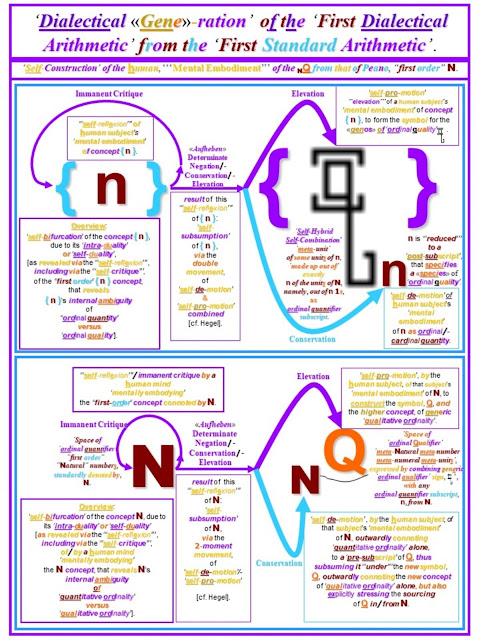

Part 05: Seldon’s Insights Series --
‘Some
Observations on the ‘Languaging’ of ‘Ordinalities’ in Modern
English and Related Dialectical-Arithmetical Matters’.
Dear Reader,
It is my pleasure, and my
honor, as an Officer of the Foundation
Encyclopedia
Dialectica [F.E.D.]
Office of Public Liaison, to share with you, from time to time, as they are approved
for public release by the F.E.D. General Council, key
excerpts from the internal writings, and from the internal sayings, of our co-founder,
Karl Seldon.
The fifth such release in this new series is entered
below [Some E.D. standard edits have been applied, in the version presented below, to the direct
transcript of our co-founder’s discourse].
For more information regarding,
and instantiations
of, these Seldonian ‘insights’,
see --
ENJOY!
Regards,
Miguel Detonacciones,
Member, Foundation Encyclopedia
Dialectica [F.E.D.],
Participant, F.E.D. Special Council for Public
Liaison,
Officer, F.E.D. Office of Public Liaison.
“... We
don’t say, in Modern English, ‘1th’, ‘2th’, and ‘3th’.”
“We don’t say ‘firstth’,
‘secondth’,
and ‘thirdth’.”
“But we do say “4th”, “5th”, “6th”, “7th”,
etc.”
“That is, the first three ordinal numbers still each retain a unique name, i.e., each with its own unique ordinal suffix or ending -- “1st”, “2nd”, “3rd” -- perhaps reflecting early impressions as to
the ‘«arché»-ic’,
‘epitomic’
and paradigmatic
character of the first
three -- and most frequently encountered
-- ordinal numbers for our [partially latent] concept of ‘ordinalities’
as a whole.”
“It “just so happens” also that our ‘‘‘dyadic’’’ and ‘‘‘triadic’’’ ‘dialectical functions’ for and of the N Q_ ‘gene-ric
«arché»-value’,
q1, also
agree, in their ‘gene-ric solution’ interpretations, only for this first triadic ‘gene-ric consecuum’
of N Q_ ‘ordinal
ontological arithmetical qualifiers’, q1 +
q2 + q3, making that triad of these first three ‘gene-ric meta-numbers’ a ‘‘‘primitive undifferentiated unity’’’ of the interpreted meaning(s) for our ‘dyadic dialectical function’ and our ‘triadic dialectical function’.”
“However, note too that, unlike in the case of our ‘triadic dialectical function’, in the case of our ‘dyadic dialectical function’, this first dialectical triad that these two ‘dialectical functions’ “have in common” -- again, ‘gene-rically’, q1 +
q2 + q3 -- does not
arise from any “Natural” number or “Whole” number ‘meta-exponent’
of the dyadic exponent, 2.”
“When that ‘meta-exponent’
is 1,
so that the entire power
of the ‘gene-ric «arché»-value’
for the ‘ultimate
ancestor’ category
of the ‘gene-ric categorial meta-genealogy’ is 21,
the resulting
‘gene-ric consecuum’
‘‘‘underflows’’’ to just ‘q121 = q12 = q1 +
q2’.”
“When that ‘meta-exponent’
is 2,
so that the entire power
of the ‘gene-ric «arché»-value’
for the ‘ultimate
ancestor’ category
of the ‘gene-ric categorial meta-genealogy’ is 22,
the resulting
‘gene-ric consecuum’
‘‘‘overflows’’’ to ‘q122 ~~ q14 ~~ q1 +
q2 + q3 +
q4’.”
“Both of these ‘meta-exponent’
values,
as well as all other possible N or
W
‘meta-exponent’
values,
fail to produce just the first dialectical triad -- ‘gene-rically’,
q1 + q2 +
q3.”
“Whereas, when the “Natural” number or “Whole number” ‘meta-exponent’
of the triadic exponent, 3, is 1, so that
the entire power
of the ‘gene-ric
«arché»-value’
for the ‘ultimate
ancestor’ category
of the ‘gene-ric categorial meta-genealogy’ is 31,
the resulting
‘gene-ric consecuum’
is precisely
‘q131 = q13 = q1 +
q2 + q3’. ...”


No comments:
Post a Comment